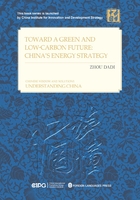
Chapter Two Energy Conservation First and the Energy Consumption Revolution
When the People’s Republic of China was founded in 1949, China was an agricultural country with an extremely backward energy industry. Except for a few large cities with limited electricity supply, most cities and all rural areas had no access to electricity. The installed power generation capacity in China was less than two million kilowatts, with an annual total power generation of 4.3 billion kWh. Back then, China produced only more than 100,000 tons of oil and had no natural gas industry at all. Coal constituted the only commercial energy, available in limited supply. After nearly thirty years of painful efforts, the total production of primary energy increased by dozens of times to 600 million tons of coal equivalent in 1980, while the electricity generating capacity raised to 300 billion kWh. However, for a population of 987 million at the time, the energy was mainly used for industrial production on a basis of planned supply, while the supply of energy for people’s lives was extremely rare.
In the 1970s, the rural population accounted for 80% of the total Chinese. Many rural areas had no access to electricity. Except for a few areas where the farmers could made use of local coal resources, there was almost zero supply of commercial energy for household consumption. Even the kerosene for lighting was rationed. The farmers mainly used raw biomass energy, such as straw and firewood, for cooking and heating. Due to the lack in fuel wood in many rural places, the farmers had to cook less and it’s common for them to have only one hot meal a day. At the time, urban housing conditions were quite mean as well. With a per capita residential area of less than 10 m2, the urban households had no home appliances except for a few electric lights. The incandescent bulbs for lighting were mostly 15 watt and 25 watt, and the 40 watt bulb would be a luxury. To cut the electricity bills, the 3-watt or 5-watt bulbs were mostly used in places not for reading. A radio may be the only home appliance for most households, while the black and white TV set was a rarity. Prior to 1980, the refrigerator was medical equipment, not for purchase by residents. Except for a few houses with central heating, a majority of urban residents could only rely on the ration of honeycomb briquette or briquette for cooking and heating. The coal must be used economically to avoid the “energy crisis” at home.
As the energy supply cannot keep up with the increasing demands, the energy shortage has long been a major problem facing the energy development in China. With a view to redressing the imbalance between supply and demand, conserving energy and eliminating waste have always been a foremost and immediate policy goal.